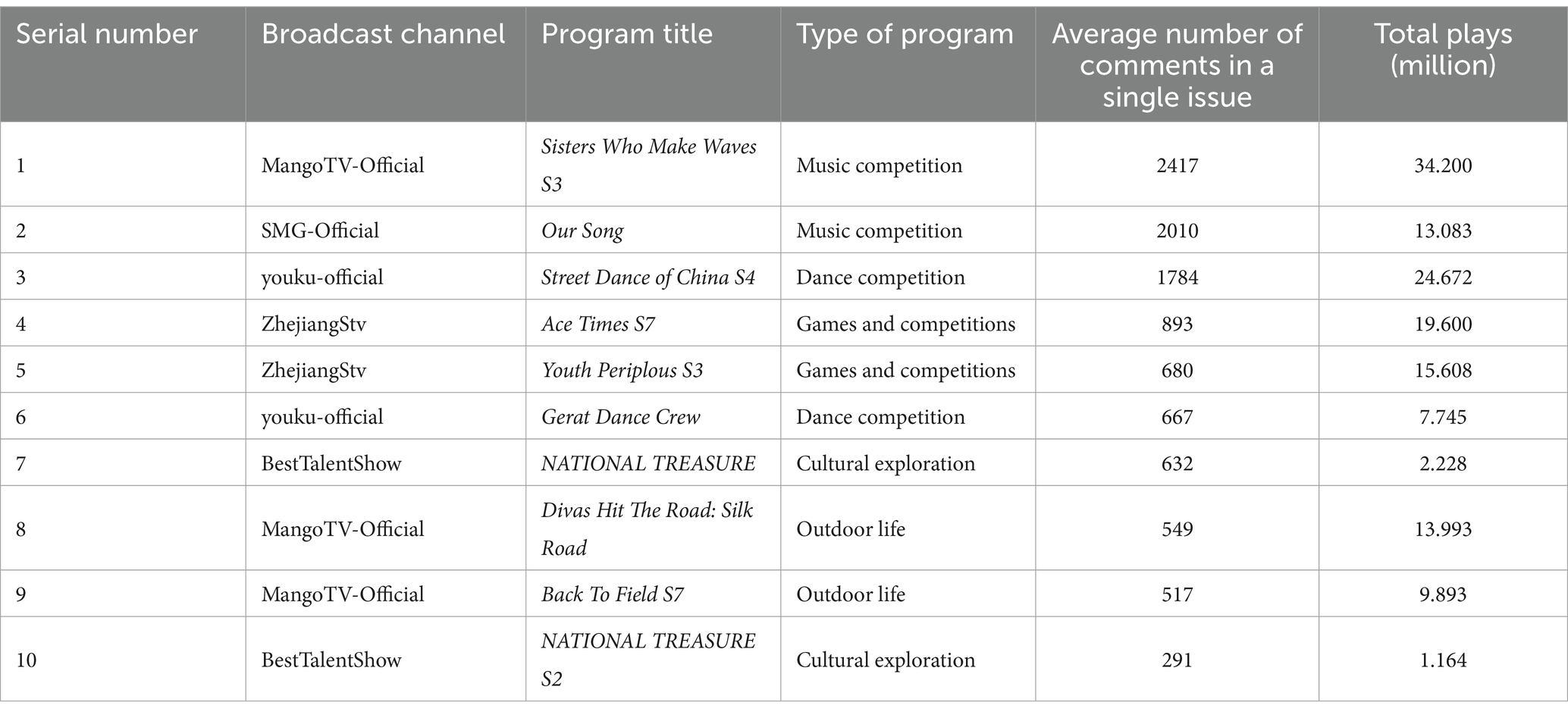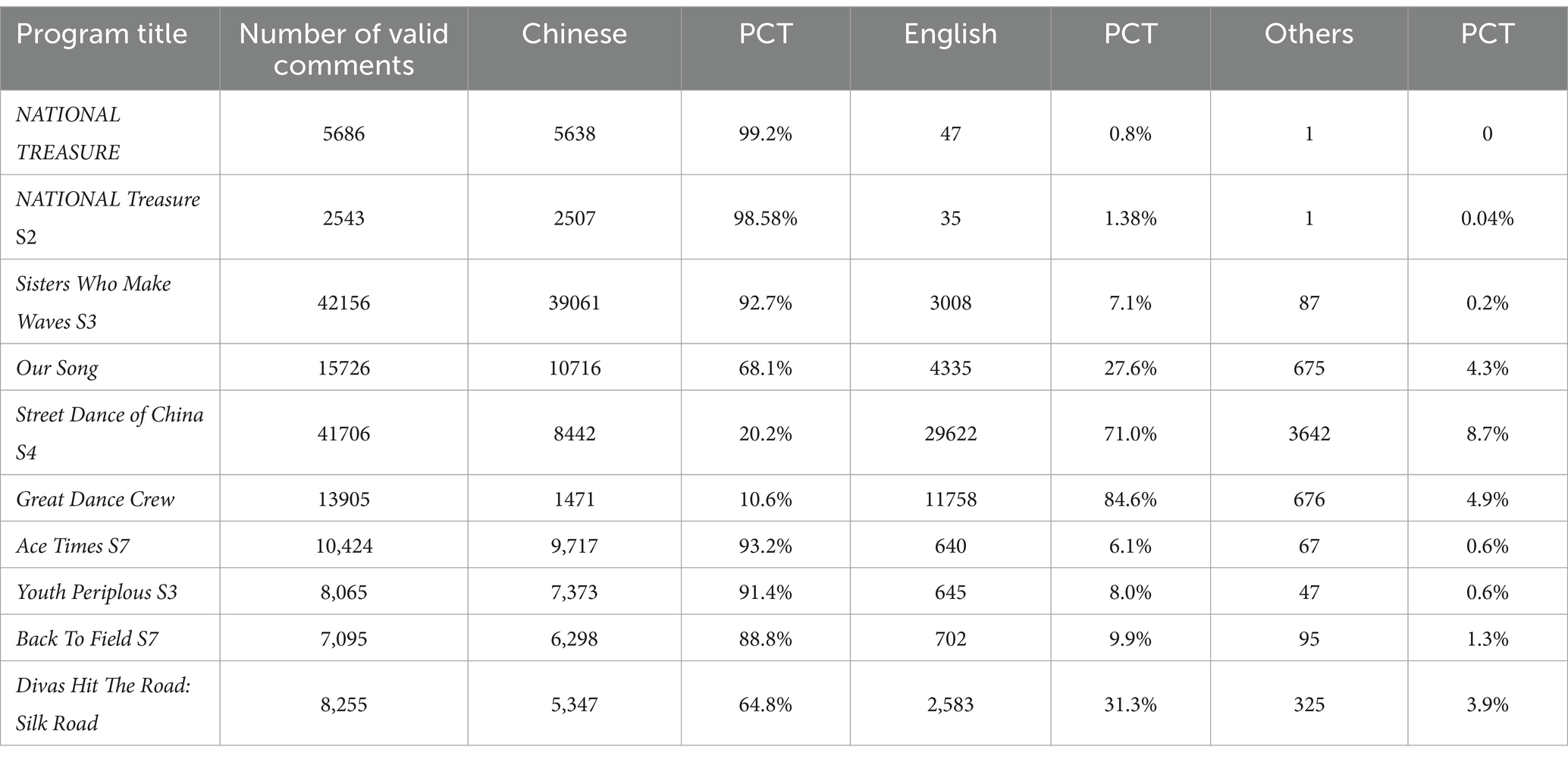- School of Journalism and Communication, Nanjing Normal University, Nanjing, China
This work investigates the international communication effects of Chinese variety shows on the YouTube platform from the perspective of cross-cultural communication using data analysis, text analysis, and communication strategy research. It is found that program genre, linguistic adaptability, presentation of universal values, and program guest selection influence cross-cultural communication to some extent. Accordingly, the effective ways to enhance the cross-cultural communication effect of Chinese variety shows include strengthening the innovation of program genres, improving the language adaptability and universal values of programs, and optimizing the selection of program guests. In cross-cultural communication, Chinese variety shows should also transform “cultural discount” into “cultural premium,” improve the operation ability of international platforms, and promote accurate global communication through localization.
1 Introduction
With China’s aim of becoming a cultural powerhouse, emphasis has been increasingly placed on international communication capacity building and the task of “presenting a real, three-dimensional, and comprehensive China.” In fact, how to build an international communication system that matches China’s comprehensive national strength and adapts to the global communication order has become a significant topic for the country (Duan, 2021). In recent years, China’s variety art field has actively explored the internationalization of original content and has set off a strong wave of “venturing overseas.” Between 2018 and 2019, the producers of more than ten iconic programs, including National Treasure, Readers and Sound of My Dream, have embarked on the Marché International des Programs de Télévision (MIPTV), aiming to present their global counterparts the unique charisma and profound heritage of China’s original variety shows. The year of 2022 saw the launch of the Spanish version of Dongfang TV’s Our Song, marking the beginning of China’s original variety show model. This was the first time that China’s original variety show model successfully landed on a mainstream platform in Europe and the United States, opening a brand new chapter of international cultural communication (Hu, 2023). The Chinese government’s “top-down digital diplomacy”strategy involves supporting positive images on multiple social media platforms, including state and non-state actors, to create a cohesive and conversational national metanarrative as effectively as possible (Zhang and Ma, 2022).
Previously, Chinese media expanded their overseas communication paths by developing international online streaming platforms. However, due to the weak technological strength, limited investment, small platform size, and fragmentation, it is difficult for such efforts to converge into a powerful platform effect, resulting in little effect on Chinese media’s overseas communication. As the main streaming media platforms, such as YouTube and Netflix and social media platforms such as Facebook, Twitter and TikTok, have grown in popularity, disseminating Chinese audio-visual content through these overseas platforms has become a new strategy for Chinese media (Wang and Lv, 2023). In recent years, some Chinese variety shows on the YouTube platform have aroused large-scale discussions among overseas users and have been liked and supported by many overseas viewers. Several culturally rich variety shows, such as National Treasure and China in Classics, have not only gained high reputations and ratings domestically but also crossed borders and created a “Chinese culture fever” on overseas platforms, allowing people from all over the world to have a glimpse of the unique charm of Chinese civilization.
Based on current research trends, existing literature on Chinese variety shows primarily focuses on domestic audience viewing behaviors, cultural identity, and market analysis, with limited attention to foreign audiences. Although Chinese variety shows have gained notable exposure on international platforms (such as YouTube and Netflix) in recent years, academic studies on how foreign audiences perceive and interpret these programs remain limited. Compared with Netflix’s closed subscription model (Gao, 2024) and TikTok’s fragmented content distribution (Kaye et al., 2020), YouTube—with its openness, search engine optimization (SEO), and recommendation algorithm—makes Chinese variety shows more accessible and continuously discoverable to overseas audiences (Alvarado et al., 2020). YouTube’s specialized recommendation algorithm closely tracks viewers’ watching behavior and interaction data, effectively capturing and reinforcing overseas audiences’ points of interest, thereby significantly enhancing programs’ international exposure and acceptance (Cho et al., 2020). Moreover, the translation culture in the comment sections and user-generated content (UGC) on YouTube further facilitate cross-cultural communication, although these features also introduce challenges such as cultural misunderstandings and controversies. Thus, it is necessary to deeply investigate the acceptance patterns and communication effects of Chinese variety shows on YouTube from a cross-cultural communication perspective.
This work explores the overseas audience acceptance of Chinese variety shows from the aspect of cross-cultural communication. The broadcasting data and audience feedback of Chinese variety shows on the YouTube platform are analyzed, which reveals the development path and the way forward for Chinese variety shows in the context of globalization. This study’s significance lies in enriching the theoretical framework in the cultural industry and media communication, as well as providing new perspectives in and empirical support for cross-cultural communication. This work selects 10 representative Chinese variety shows from the YouTube platform regarding program genres, communication data and feedback. The content analysis method is used to explore the attitudes of overseas audiences towards Chinese variety shows in terms of awareness, concern, and emotional inclination.
This work is divided into four core sections. The first section elaborates on the principal foundations of this work. In the second section, the background literature is elaborated to lay a solid foundation for subsequent research. In the third section, the methodology used to conduct this work is described to ensure the scientific and rigorous nature of the research process. In the fourth section, content analysis and casework methods are implemented to analyze the likes, views and comments given to Chinese variety shows on YouTube platforms. Then, the results derived from this study are analyzed and discussed. It is found that the marketing techniques of a Chinese variety show on the YouTube platform are not always as successful as expected, suggesting the need for a more detailed evaluation of the types of engagement sought by the platform and how audiences respond to it in different overseas contexts.
2 Literature review
2.1 Previous research on Chinese variety shows
2.1.1 Integration of Chinese variety shows and culture
Studies focus on how Chinese variety shows spread Chinese cultural elements in various contexts through cultural adaptation and localization strategies. Research has shown that when variety shows are introduced to overseas markets, through the localization of content and adaptation of cultural elements, these shows are often made to fit more closely with the cultural background and aesthetic needs of local viewers, thus increasing their acceptance of Chinese culture.
Besides, Chinese variety shows have achieved a deep level of cultural integration internationally by enhancing their cultural identity (Hu, 2022). In this regard, the Cultural Proximity Theory offers a theoretical explanation, suggesting that audiences are more inclined to accept media content that is culturally similar to their own in terms of language, values, and aesthetics. Chinese variety shows utilize this theoretical framework by appropriately adapting cultural elements to reduce the psychological distance from overseas viewers, thereby achieving enhanced communication effects. Scholars have also observed that even though some programs ostensibly pursue entertainment, there is a hidden cultural export strategy behind them, aimed at expanding the global influence of Chinese culture through the enhancement of cultural identity (Hu and Wang, 2021). This cultural integration helps enhance China’s international image and provides a new way to expand the country’s soft power (Bai, 2015). At the same time, according to the Uses and Gratifications Theory, overseas audiences watch Chinese variety shows not merely for entertainment but also to satisfy specific psychological or cultural needs, such as curiosity, knowledge-seeking, or cross-cultural experiences (Tirasawasdichai et al., 2022). This theoretical perspective provides a deeper explanation for why foreign audiences actively engage with and appreciate Chinese cultural programs.
2.1.2 Social impact of variety shows in China
Firstly, research has focused on cultural propaganda and the shaping of social values. Entertainment programs have strengthened viewers’ identification with Chinese culture and social values through multi-level cultural narratives, becoming an essential part of the country’s soft power. Some programs have successfully aroused viewers’ interest in and identification with traditional culture through innovative cultural narratives, similarly reflecting the great potential of variety shows regarding social impact (Guo, 2019).
Secondly, the cross-cultural communication and social impact were investigated. Some studies have found that Chinese variety shows have positively impacted the social identity and cultural understanding of the international community in the process of cross-cultural communication. Scholars have pointed out that through cross-cultural content exchange, several Chinese variety shows have enhanced international viewers’ understanding of Chinese culture and cultural interactions on a global scale (Li, 2024). It has also been found that by presenting real-life social phenomena and life situations, television media effectively promotes viewers’ reflections on social issues, influencing people’s social behaviors and attitudes (Dosekun, 2015).
2.1.3 Comparative study on variety shows in China and other countries
In the context of globalization, differences exist between Chinese variety shows and those of other countries in terms of cultural expression, innovation, and social impact. For example, studies comparing Chinese and Korean variety shows have highlighted that Chinese shows have gained international recognition through cultural adaptation and localization strategies (Jiang, 2018). Korean shows, on the other hand, emphasize formal innovation and visual effects, while Chinese shows focus more on cultural connotations and the transmission of traditional values (Keane and Zhang, 2017).
Additionally, South Korean variety shows represent one of the most successful cases in international media communication, driving the powerful global wave known as the “Korean Wave” (Hallyu). Variety shows such as Running Man have achieved remarkable success on international platforms like YouTube and Netflix. These programs commonly emphasize entertaining formats, charismatic guests, precise targeting of audience demographics, and effective utilization of YouTube’s interactive commenting mechanism, thereby creating highly engaged global fan communities and successfully promoting Korean pop culture internationally (Li, 2020). While Chinese variety shows possess advantages in localization and cultural integration, they still face limitations in interactivity and precision during international dissemination, including insufficient audience interaction and notable cultural misunderstandings (Croucher and Condon, 2019). Therefore, a comparative analysis between Chinese and South Korean variety shows helps uncover the strengths and weaknesses of Chinese programs in international communication, thus providing a clearer roadmap for optimizing the overseas dissemination strategies of Chinese variety shows in the future.
2.2 Streaming media platforms
2.2.1 Audiences and business models for streaming platforms
With the rapid growth of streaming media platforms worldwide, their audience segments and business models have become an essential area of academic research, which has revealed how streaming platforms attract and maintain a diverse user base through innovative business strategies and technological means.
On the one hand, the popularity of streaming services has led to significant changes in audience behavioral patterns. Studies have found that the audience of streaming platforms is not limited to traditional TV viewers but covers a broader group, including young people and late-night users, whose viewing patterns tend to revolve around nighttime, which makes the “prime time” of streaming platforms different from that of traditional TV (Tana et al., 2019).
On the other hand, streaming platforms are gradually adapting their profitability models, for example, by shifting from traditional advertising-driven models to subscription and pay-per-view schemes. Scholars have emphasized that this shift is to better suit modern audiences’ needs. At the same time, competition between platforms increasingly relies on the uniqueness and richness of content, which makes producing original content and purchasing copyrights one of the core strategies of streaming platforms (Burroughs, 2019).
2.2.2 Impact of streaming media versus other types of media
The development of streaming technologies has had a profound impact on traditional media and has reshaped the media ecosystem on a global scale.
Streaming media delivers content directly to users by bypassing traditional distribution channels, which undoubtedly undermines the mediating role of the latter (Herbert et al., 2019). The personalization and convenience of online TV services allow viewers to watch programs according to their personal schedules, and this possibility of self-scheduling enhances viewing immersion and lends itself to complex narratives (Lüders and Sundet, 2022). In addition, streaming platforms’ personalized recommendation systems and user data analytics capabilities enable them to meet audience needs more precisely, increasing user stickiness and improving profitability (Andersen et al., 2021).
Furthermore, streaming has provided a wealth of opportunities for independent producers and niche content to be widely distributed and has enabled the widespread distribution of content previously inaccessible to the mainstream market (Spilker and Colbjørnsen, 2020). However, global streaming giants such as Netflix and Spotify have dominated significant trends in media consumption and have exerted a massive influence on the production and distribution of culture on a global scale (Lüders, 2020). This two-way mechanism of influence has enriched cultural diversity and equally raised concerns about market monopolization by streaming platforms and cultural homogenization.
2.3 Intercultural communication
2.3.1 Cultural globalization and civilizational engagement
Cultural globalization promotes a mutual understanding between Chinese and foreign cultures through exchanging concepts and values. It also has academic reference value for firming China’s cultural self-confidence. Foreign research in this area is relatively extensive with a long history. Scholars have mainly focused on two aspects in this field.
Firstly, there are studies centered around the “clash of civilizations” school. Some scholars have argued that since the end of the Cold War, the world political situation has manifested itself for the first time in a multipolar and multicivilizational state (Huntington, 2010) and that the Oriental-Western dichotomy of cultural identities is a theory of domination by strong cultures over weak ones (Said, 1999).
Secondly, research has touched on the “dialogue of civilizations” school. Scholars have argued that relationships between regions are fading (Kotkin, 2010) and that culturally specific religions, ethnicities, and their worldwide commercial and cultural networks will serve as a link between human beings, connecting dispersed globalized communities and increasingly shaping the fate of the human economy (Castells, 2006).
2.3.2 Effectiveness of intercultural communication
Regarding the factors affecting the effectiveness of cross-cultural communication, a country’s economic strength, population size and cultural similarity play a significant role in disseminating international news. Some scholars have pointed out that powerful countries are more likely to set agendas and influence global public opinion through the media. Meanwhile, countries with smaller economies and populations can effectively convey their own national issues under certain circumstances. In addition, countries with closer economic ties are more inclined to report each other’s news, and similar cultures are more likely to influence each other in international news dissemination, yielding the complex dynamic nature of cross-cultural communication (Guo and Vargo, 2020).
On the other hand, cross-border media flows have demonstrated a potentially positive role of cross-cultural communication effects in reducing interstate tensions through public diplomacy. Research has found that social media platforms, such as Facebook and YouTube, have become essential platforms for citizen-initiated peace communication, reducing the potential risk of violence and conflict by emphasizing shared culture, values and collective well-being (Kumar and Semetko, 2018). Although the specific effects of peace communication are difficult to quantify, it has been shown that such citizen-driven cross-cultural communication can go some way to influence the political climate between countries and prevent the escalation of conflict (Jakobsen, 2000).
3 Research methodology
In the context of globalization and the worldwide use of the YouTube platform, Chinese variety shows have gradually become a window for international audiences to learn about Chinese culture and society. However, the exact acceptance and influence of these programs in the international market and the factors that specifically impact their reach and audience acceptance have not yet been systematically researched. To address this issue, this work aims to explore the overseas audience acceptance of Chinese variety shows in cross-cultural communication on the YouTube platform. To examine this issue more clearly and visually, this work adopts a content analysis approach, which involves systematically examining viewer comments to identify recurring themes, emotional tendencies, and cross-cultural responses through word frequency analysis, sentiment classification, and co-occurrence mapping.
3.1 Sample selection
This study selected the ten most representative Chinese variety shows on YouTube based on channel views and comment counts (see Table 1). The data were collected from the official YouTube channels of program producers or broadcasters, covering five categories: music competitions, dance competitions, game shows, cultural exploration, and outdoor life. These programs were ranked according to their average number of comments per episode to ensure representativeness and audience engagement.
First, the initial selection criteria were based on the overall channel views, as programs with higher total views typically have greater international influence and a broader audience base. Second, among these high-exposure channels, programs were further selected according to the average number of comments per episode, thus identifying shows with higher viewer interaction and richer comment data to support the subsequent textual analysis adequately. Third, to ensure the timeliness and validity of this research, the selected programs had to have been officially completed by August 2024 (the experiment’s date) and originally broadcast no earlier than 2019. This decision is based on communication research conventions that emphasize data timeliness, as data closer to the time of the study can more accurately reflect the latest media communication trends and audience feedback (Wimmer and Dominick, 2013). Additionally, comment data tends to stabilize after a program concludes, enhancing the reliability and validity of research findings (Song et al., 2021). Finally, unofficially uploaded program clips were excluded to ensure the authenticity and reproducibility of the data used in this study.
3.2 Sample processing
This work adopts the research method of combining data analysis with text analysis to explore the attitudes of overseas audiences towards Chinese variety shows in terms of their awareness, concern, discussion, emotional inclination, and value orientation. Specifically, the real-time comments of the above ten variety shows during the period from 2017 to 2024, since their respective broadcast dates, were collected from the website “Export Comments.” After excluding meaningless samples such as purely emoticon samples and non-verbal samples, a total of 158,192 comments were captured, and 155,561 valid comments were obtained.
First, after obtaining comments from YouTube, this study adopted a manual filtering approach to remove spam or bot-generated comments. Initially, researchers excluded comments that exhibited common characteristics of spam, such as obvious promotional links (keywords like “http://,” “www,” “subscribe,” “visit my channel”), meaningless repetitive texts, standalone links, excessive repetition of words, excessive use of special characters (such as “!!!,” “???”), and meaningless emoji-only comments. Additionally, the researchers manually checked the logic and coherence of the comments to ensure that the analyzed comments were written by authentic users, thus ensuring the validity and accuracy of the analysis results.
Second, when dealing with the comment samples, this work first counts the number and percentage of comments in each language in the ten programs according to the three categories of “Chinese,” “English” and “Others,” and draws a map of the distribution of the languages of the corresponding programs, along with a distribution map for each program.
Finally, the word frequency and sentiment tendency of the comments of the ten variety shows are counted by the “Micro Word Cloud” software, and the keyword word cloud maps of the corresponding shows are created to compare and analyze the main concerns of the comments of different shows. Considering that AI-based sentiment analysis tools may carry potential misinterpretation risks when detecting sarcasm, humor or irony, this study conducted a manual cross-validation to enhance the reliability of sentiment analysis results. When individual misclassifications were identified, researchers further adjusted and optimized specific keywords in the platform’s backend, thereby minimizing the sentiment analysis error rate.
4 Discussion and analysis of empirical results
Based on Table 1, the ten variety shows were grouped into five genres, using the number of comments to highlight differences in cross-cultural acceptance and audience engagement across programs.
In terms of overall figures, music competition programs were the most popular among viewers. Sisters Who Make Waves S3 and Our Song topped the charts for comments and views, averaging 2,417 and 2,010 comments per episode and garnering 34,200,000 and 13,083,000 views, respectively. This indicates that music competitions can effectively attract viewers, generating a high level of discussion and engagement. In addition, dance competition programs also performed well, especially the Street Dance of China S4 youku-official that gained 1,784 single-period average comments and 24,672,000 total broadcasts, which further proves that overseas viewers have high interest in and willingness to interact with dance programs.
Music and dance variety shows achieve higher audience engagement likely due to two key factors. First, these programs have a relatively low dependence on language, as their performances and emotional expressions are primarily conveyed through visual and auditory channels, enabling them to overcome language barriers and resonate with audiences across diverse cultural backgrounds (Garrido and Macritchie, 2018). Second, these shows offer strong auditory and visual appeal, and rich audiovisual elements effectively capture viewers’ attention and evoke emotional resonance, subsequently prompting more frequent and active online interactions, such as liking, commenting, and sharing (Theodorou et al., 2019). This indicates that the effectiveness of cross-cultural communication for different program types is closely related to their language dependency and audiovisual appeal.
Traditional TV stations and online video platforms were found to play an important role in broadcast channels. Among them, MangoTV-Official topped the list with the interactive popularity king Sisters Who Make Waves S3 and two outdoor lifestyle programs Divas Hit The Road: Silk Road and Back to Field S7, which were particularly outstanding in terms of audience interaction and broadcast volume; youku-official, ZhejiangStv and BestTalentShow each took up two programs in the dance competition, game contest and game show, respectively, which have a strong layout and audience attraction in the three categories of dance competitions, game competitions and cultural explorations; SMG-Official, with over 2,000 comments per episode, demonstrated exceptional strength in the field of cross-cultural communication with its original music variety show Our Song, transitioning from “Global Shopping” to “Global Broadcasting. “.
In this work, based on the review information collected for ten programs, the review data were screened to obtain the most effective number of reviews. The percentage of comment language of each program was counted by the method of classification and generalization, as shown in Table 2.
4.1 Cross-cultural acceptance of cultural exploration programs
Among the ten programs screened for this work, 20% were in the cultural exploration category, with the titles NATIONAL TREASURE and NATIONAL TREASURE S2.
NATIONAL TREASURE is an innovative cultural variety show that focuses on heritage conservation and cultural inheritance and is produced by CCTV. The program not only showcases the historical stories behind cultural relics innovatively and deciphers the profound heritage of Chinese civilization to viewers but also attracts broad participation through its lively variety show format. Building on this foundation, NATIONAL TREASURE S2 continued this success from 9 December 2018, showcasing more cultural relics and history through legendary stories and guardian narratives.
4.1.1 Text description
4.1.1.1 NATIONAL TREASURE
As shown in Table 2, this article obtained 5,686 valid comments about the first season of NATIONAL TREASURE after excluding meaningless ones such as numbers and emoticons. Chinese comments dominate, reaching 5,638, accounting for 99.2% of the total comments. There are only 47 English comments, accounting for 0.8%, and only one comment in other languages, which is considered negligible.
Regarding the overall figures, NATIONAL TREASURE’s viewer base is mainly concentrated among Chinese-speaking viewers, which aligns with the program’s positioning that its content is deeply rooted in traditional Chinese culture and geared towards Chinese-speaking audiences. By showcasing Chinese historical relics and cultural stories, the program has successfully attracted many Chinese-speaking viewers and gained high recognition and popularity in the local market. Although the presence of English-language comments does not account for a high percentage of the program, it indicates that the program has a certain level of attention among international viewers and may be disseminated to overseas audience groups through subtitles or other forms.
4.1.1.2 NATIONAL TREASURE S2
As shown in Table 2, NATIONAL TREASURE S2 received 2,543 valid comments. Among them, 2,507 comments were in Chinese, accounting for 98.58% of the total number of comments; 35 comments were in English, accounting for 1.38%; and only one comment was in other languages, accounting for 0.04%, which is ignored for the purpose of this study.
As can be seen from these figures, on the one hand, Chinese comments continue to dominate the comments section of the NATIONAL TREASURE series, occupying the vast majority. This high proportion of Chinese comments reflects the popularity of the program content among Chinese viewers. On the other hand, despite the low number of English comments, which account for only 1.38%, there is a slight increase in this percentage compared to NATIONAL TREASURE season 1, which may be related to the enhanced program dissemination on international platforms. The proportion of comments in other languages is deficient and almost negligible, indicating that the program’s influence and dissemination among language groups other than Chinese and English is still minimal.
4.1.2 Word frequency, sentiment and co-occurrence network analysis
4.1.2.1 NATIONAL TREASURE
The analysis of 5,611 valid comments on National Treasure revealed a total vocabulary of 31,509 words, with 8,095 valid words and a word density of 25.69%. Sentiment analysis showed that 41.1% of the comments were positive, 35.41% were neutral, and 23.49% were negative (Grouped under “Cultural exploration” in Table 3).
Positive comments praised the innovative presentation of cultural relics and the transmission of Chinese culture, focusing on content, storytelling, and cultural significance. Neutral comments offered suggestions on the program’s pacing, interpretations, and hosting styles, reflecting diverse viewer opinions. Negative comments primarily criticized the pacing and lack of depth in certain episodes.
Word frequency analysis highlighted terms such as “cultural relics,” “culture,” “history,” “museum,” and “story,” indicating strong interest in cultural heritage and the program’s educational value. Overall, the show received positive feedback for its cultural innovation, though improvements in pacing and interpretive content were suggested to meet diverse audience expectations (see Figure 1).

Figure 1. NATIONAL TREASURE comment section keyword cloud map – audience focuses on culture, history, artifacts, and related cultural symbols.
4.1.2.2 NATIONAL TREASURE S2
The analysis of 2,510 valid comments on National Treasure S2 revealed a total vocabulary of 23,932 words, with 7,724 valid words and a word density of 32.27%. Sentiment analysis showed that 38.72% of the comments were positive, 38.17% were neutral, and 23.11% were negative (Grouped under “Cultural exploration” in Table 3).
Positive comments highlighted the program’s excellent performance in promoting cultural heritage and the presentation of relics. Viewers expressed appreciation for its role in promoting Chinese culture and telling the stories behind the relics. Neutral comments mainly offered suggestions on program details, while negative comments focused on pacing and content presentation.
Word frequency analysis indicated high-frequency terms like “cultural relics” “history” “culture” and “explanation” showing audience interest in cultural connotations and relic stories. Terms such as “conservation” and “inheritance” reflect concerns about heritage preservation (see Figure 2).
In conclusion, National Treasure S2 maintained the cultural heritage focus of the first season, though it received generally positive feedback, there is still room for improvement in pacing and narrative style.

Figure 2. NATIONAL TREASURE S2 comment section keyword cloud map – audience shows strong interest in regional cultural diversity and local heritage.
4.2 Intercultural reception of music competition programs
Among the ten programs screened for this work, the music competition category accounted for 20% of the programs, with the titles Sisters Who Make Waves S3 and Our Song.
Sisters Who Make Waves S3 is a self-produced inspirational and growth music competition show that aired on Mango TV on 20 May 2022. The program brings together 30 singers, actors and dance artists to showcase breakthrough performances with the support of a professional team.
Our Song is an intergenerational hip-hop music competition show launched by Oriental TV. It aims to encourage new-generation singers to collaborate with classic singers in the Chinese music industry to recreate classic golden songs. The show premiered on 27 October 2019 and has attracted widespread attention through intergenerational music creation.
4.2.1 Text description
4.2.1.1 Sisters Who Make Waves S3
From the review data shown in Table 2, Sisters Who Make Waves S3 received 42,156 valid reviews. Among them, the number of Chinese comments is 39,061, accounting for 92.7% of the total comments; the number of English comments is 3,008, accounting for 7.1%; and the number of comments in other languages is 87, accounting for 0.2%.
As a music competition program focusing on mature female artists, Sisters Who Make Waves S3 has attracted a sizeable Chinese audience base and sparked extensive discussions through its innovative format and unique cultural expression style. Regarding language share, Chinese comments are still dominant, which also supports that the program has a higher influence and popularity among Chinese viewers.
For this program, the percentage of English comments reached 7.1%. The music and dance elements involved appeal to overseas audiences in cross-cultural communication, and the international popularity of the program’s guests further promotes the program’s spread among overseas audiences.
4.2.1.2 Our Song
As shown in Table 2, Our Song received 15,726 valid comments, with 68.1% (10,716) in Chinese, 27.6% (4,335) in English—a high proportion among similar programs,and 4.3% (675) in other languages.
The program’s innovative intergenerational cooperation format attracted significant engagement from Chinese viewers, with Chinese comments making up about two-thirds of the total, highlighting its strong domestic appeal. The 27.6% of comments in English suggests Our Song has gained traction in the international market, especially among English-speaking audiences, likely due to music’s cross-cultural nature and the presence of internationally recognized guests.
Although only 4.3% of comments were in other languages, this still demonstrates its reach among multilingual audiences. As globalization progresses, Our Song has the potential to further expand its presence in the global market.
4.2.2 Word frequency, sentiment and co-occurrence network analysis
4.2.2.1 Sisters Who Make Waves S3
In the analysis of reviews for Sisters Who Make Waves S3, 2,866 valid reviews were collected, with a total word count of 41,592, a valid word count of 3,905, and a word density of 9.39%. Sentiment analysis showed a predominantly positive trend, with 48.5% (1,390) positive reviews, 42.29% (1,212) neutral, and only 9.21% (264) negative (Grouped under “Music competition” in Table 3).
Positive comments focused on keywords like “stage effect,” “effort,” and “breakthrough,” with viewers praising the performances as “wonderful,” “excellent,” or “touching.” Neutral comments offered suggestions for specific stage performances, while negative feedback targeted “program branding” and “individual performances.”
Co-occurrence network analysis, as shown in Figure 3, revealed core terms like “you,” “her,” and “she,” highlighting the audience’s focus on independent female artists. Words such as “show,” “successful,” and “positive” indicated strong interest in the stage performances and team dynamics, while frequent mentions of names like “Jessica,” “Cyndi,” and “Kelly” suggested widespread discussion around the contestants.
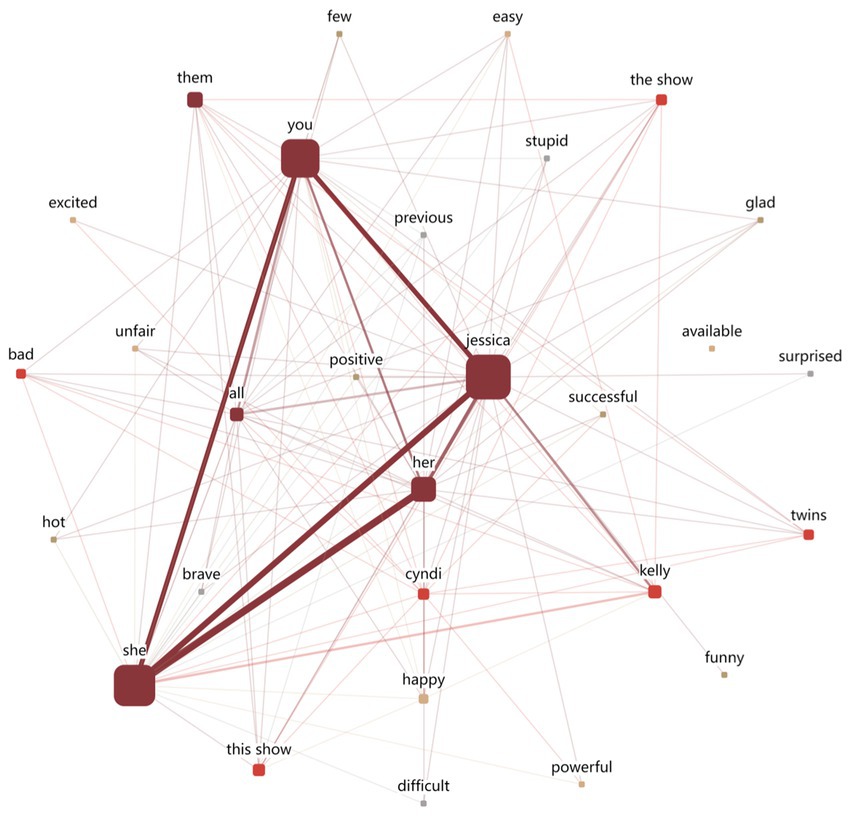
Figure 3. Sisters Who Make Waves S3 comment section keyword co-occurrence network relationship map – audience shows strong interest in independent female artists and stage performances.
Overall, Sisters Who Make Waves S3 received positive emotional feedback, with its innovative competition format and the contestants’ perseverance being widely appreciated by viewers.
4.2.2.2 Our Song
The review analysis of Our Song collected 4,332 valid comments, comprising 66,989 words, with 5,329 valid words and a word density of 7.96%. Sentiment analysis showed that 58.1% (2,517) of the reviews were positive, 36.89% (1,598) were neutral, and only 5.01% (217) were negative (Grouped under “Music competition” in Table 3).
Positive comments praised the program’s innovative format, intergenerational collaborations, and emotional resonance. Viewers especially appreciated the adaptation of classic songs and stage performances, with frequent mentions of words like “wonderful,” “touching,” and “professional.” Neutral comments focused on the show’s format, while negative comments reflected dissatisfaction with certain aspects of the show.
As shown in Figure 4, co-occurrence network analysis revealed high-frequency terms such as “Xiao Zhan,” “you,” “thanks,” “fantastic,” and “brilliant,” indicating strong audience support for specific contestants. The frequent appearance of “English subtitles” highlights the program’s international reach and the importance of subtitles for overseas viewers. Words like “precious,” “proud,” “powerful,” and “honour” reflect the performers”emotional expression and cooperation, showcasing the program’s positive image.
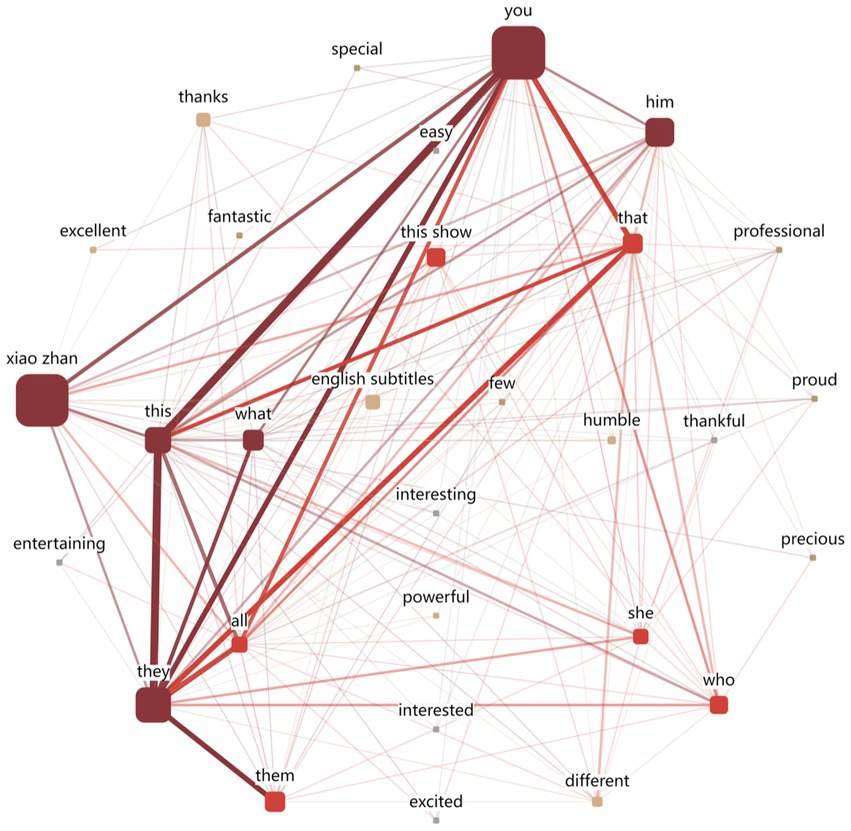
Figure 4. Our Song comment section keyword co-occurrence network relationship map – audience highly appreciates intergenerational collaboration and emotional resonance.
Overall, Our Song was highly praised for its innovative format and quality performances, particularly in cross-generational collaboration and emotional resonance.
4.3 Dance competition category
Among the ten programs screened for this work, the dance competition category accounted for 20% of the programs, with the titles Street Dance of China S4 and Great Dance Crew.
Street Dance of China S4 premiered on 14 August 2021 as a street dance audition reality show on Youku. The program uses the “celebrity mentors + professional dancers” model to determine a final champion through individual auditions and team battles.
Great Dance Crew premiered on 16 April 2022 as a competitive reality show featuring women dancing together. The show conveys women’s empowerment by showcasing young female dancers’ individual expression and team cohesion.
4.3.1 Text description
4.3.1.1 Street Dance of China S4
As can be seen in Table 2, Street Dance of China S4 received 41,706 valid reviews. Among them, the number of Chinese comments was 8,442, accounting for 20.2% of the total comments; the number of English comments was 29,622, accounting for 71.0%; and 3,642 comments in other languages accounted for 8.7%.
Looking at the overall figures, Street Dance of China S4 has shown great appeal in the international market, especially among English-speaking viewers who far outweigh domestic viewers. The international influence of celebrity mentors may be one of the crucial factors driving extensive overseas attention to these programs. For instance, celebrity mentors in Street Dance of China S4 include Wang Yibo, Han Geng, and Henry Lau, who not only enjoy substantial domestic popularity but also have established considerable international fanbases. Henry Lau, a Korean-Canadian artist, holds widespread influence in global K-pop circles, while Wang Yibo, recognized both as an actor and singer, has garnered significant attention in Asian and Western markets. The cross-cultural profiles of these celebrity mentors enhance the accessibility and artistic appeal of the program for international viewers, encouraging them to participate more actively and form stronger emotional connections with the show’s content. Additionally, the mentors’ personal charisma and the competitive design of the show increase audience immersion, further contributing to higher engagement rates.
The percentage of comments in other languages was 8.7%, indicating that the program is equally influential among multi-lingual audiences other than Chinese and English. As the program has been widely promoted on overseas social media platforms, dancer friends and dance enthusiasts worldwide have participated in the discussion, bringing a more diverse global audience to the program.
4.3.1.2 Great Dance Crew
As shown in Table 2, Great Dance Crew received 13,905 valid reviews. Among them, the number of Chinese reviews is 1,471, accounting for 10.6% of the total; the number of English reviews is 11,758, accounting for 84.6%; and the number of reviews in other languages is 676, accounting for 4.9%.
Like Street Dance of China S4, Great Dance Crew has also appealed strongly to the international market, especially English-speaking audiences. The combined percentage of reviews in English and other languages reaches 89.5%, far exceeding Chinese reviews. This shows that the program has gained widespread attention and discussion worldwide, especially in English-speaking cultural circles. This further confirms that dance as an art form with cross-cultural appeal makes a program effective in attracting audiences from different language backgrounds (Robertson, 1995).
In addition, the Chinese comments, though relatively few, still reflect the program’s specific influence on the domestic market. This may be due to the program’s more international positioning or promotion on the YouTube platform, which has attracted more overseas viewers, while Chinese viewers have provided more support and attention to the program’s dissemination domestically.
4.3.2 Word frequency, sentiment and co-occurrence network analysis
4.3.2.1 Street Dance of China S4
The analysis of Street Dance of China S4 reviews yielded 29,621 valid comments, with a total vocabulary of 561,853 words, 19,136 valid words, and a word density of 3.41%. Sentiment analysis showed that 51.02% of the comments were positive, 38.64% were neutral, and 10.34% were negative (Grouped under “Dance competition” in Table 3).
Viewers appreciated the dancers’ performances, innovative choreography, and stage effects. Positive comments focused on choreography, mentorship, and contestants’ progress, while neutral feedback offered suggestions for improvement. Negative comments mainly addressed competition arrangements and editing.
The co-occurrence network analysis reveals high-frequency words, and their associations within audience comments. As illustrated in Figure 5, terms such as “supportive,” “impressive,” “nervous,” “familiar,” and “funny” appear frequently. This indicates that viewers pay close attention to the dancers’ and mentors’ performances and interactions, as well as the tension of the competition. Meanwhile, names of mentors such as “Wang Yibo” and “Henry,” along with words like “team,” “serious,” and “excited,” frequently appear, demonstrating strong audience interest in dancers’ performances, mentor interactions, and teamwork.
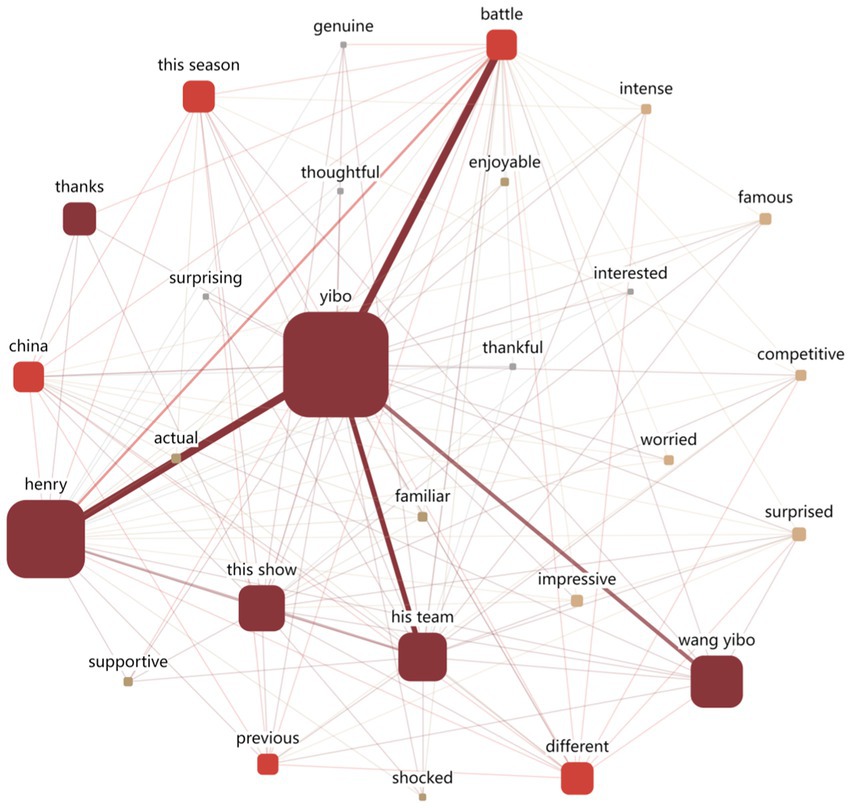
Figure 5. Street Dance of China S4 comment section keyword co-occurrence network relationship map – audience highly values performances, innovative choreography, and mentor interactions.
Notably, celebrity mentors significantly enhance the show’s international exposure and influence audience emotional expression. English comments frequently discuss mentors’ personal styles and cross-cultural evaluations. International viewers are attracted not only to the dancing performances but also to the mentors’ cultural backgrounds and charisma. Mentors’ interactive styles and relationships with contestants further enhance emotional connections, prompting deep interactions within the comment sections, thus boosting audience engagement and increasing the show’s discussion and popularity.
In conclusion, Street Dance of China S4 received generally positive feedback for its choreography and mentorship, though some criticism was directed at its competition format and editing.
4.3.2.2 Great Dance Crew
The analysis of Great Dance Crew reviews yielded 11,756 valid comments, with a total vocabulary of 182,456 words, 9,349 valid words, and a word density of 5.12%. Sentiment analysis indicated 48.92% positive comments, 42.97% neutral, and 8.11% negative (Grouped under “Dance competition” in Table 3).
Positive feedback centered on the dancers’ performance, choreography, and stage effects, with viewers praising the creative choreography and dancers’ professionalism. Neutral comments mainly offered suggestions on the program’s structure, while negative feedback focused on the setup and post-production issues.
Co-occurrence network analysis, as shown in Figure 6, revealed frequent terms such as “attractive,” “impressive,” “strong,” “familiar,” and “honest,” with the latter two closely linked to the dancers” performances. Mentors and teamwork were also frequently mentioned, with names like “Cheng Xiao” and “Santa” indicating a positive connection between guest choices and the program’s popularity.
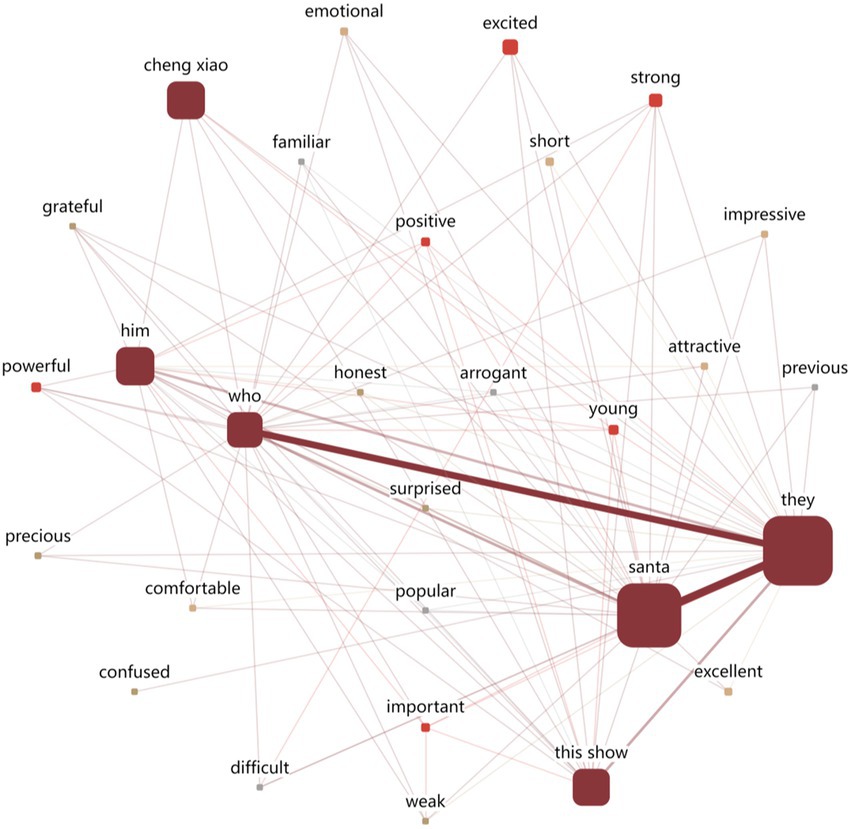
Figure 6. Great Dance Crew comment section keyword co-occurrence network relationship map – audience appreciates professional performances, choreography, and mentor selections.
In conclusion, Great Dance Crew received widespread praise for its professional performances and choreography, though there remains room for improvement in pacing and editing.
4.4 Game competition category
Among the ten programs screened for this work, the game competition category accounted for 20% of the programs, including the titles Ace Times S7 and Youth Periplous S3.
Ace Times S7 premiered on 25 February 2022. The program revolves around different themes, with two ace teams competing in talent and game competitions in PK duels. A highlight of the program has been its focus on celebrities’ emotions within a limited space and combining stage, lighting and music to enhance emotional resonance.
Youth Periplous S3 focuses on certain games and challenges guests face on the road. Premiering on 6 November 2021, the “Spring Outing Family” comprising Jia Ling, Yang Yang, Fan Chengcheng and other members work together as a team to complete a variety of fun games and tasks, demonstrating the tacit understanding and competitive spirit among the members.
4.4.1 Text description
4.4.1.1 Ace Times S7
As shown in Table 2, Ace Times S7 received 10,424 valid reviews, with 93.2% (9,717) in Chinese, 6.1% (640) in English, and 0.6% (67) in other languages.
The program significantly attracted Chinese viewers, as evidenced by the overwhelming proportion of Chinese-language comments. This indicates Ace Times S7‘s strong influence and broad appeal in the Chinese market. As a celebrity interactive variety show, it has maintained a loyal Chinese audience through its celebrity guests, engaging games, and relaxed atmosphere. The high percentage of Chinese comments reflects the program’s alignment with local cultural preferences and entertainment expectations.
Although English-language comments accounted for only 6.1%, they demonstrate a certain degree of international attention, particularly from overseas viewers interested in Chinese culture and entertainment. The minimal percentage of comments in other languages (0.6%) suggests limited reach beyond Chinese and English-speaking audiences, likely due to relatively weak international promotion.
4.4.1.2 Youth Periplous S3
As shown in Table 2, Youth Periplous S3 received 8,065 valid reviews, with 91.4% (7,373) in Chinese, 8.0% (645) in English, and 0.6% (47) in other languages.
The program primarily attracted Chinese viewers, with the majority of comments in Chinese, reflecting its strong relevance to local cultural interests and entertainment preferences. As a variety show combining celebrity interaction and travel experiences, Youth Periplous S3 appealed to a broad Chinese audience, particularly young viewers, through its entertaining travel segments and games. The high proportion of Chinese comments highlights the audience’s enthusiasm and active engagement.
Although English comments accounted for 8.0%, this suggests some international appeal, particularly among overseas viewers with an interest in Chinese culture. The light-hearted format and international popularity of the celebrity guests contributed to discussions outside of China.
The small percentage of comments in other languages (0.6%) indicates limited reach beyond Chinese and English-speaking audiences, suggesting potential for growth in its international distribution and influence in multilingual markets.
4.4.2 Word frequency, sentiment and network co-occurrence analysis
4.4.2.1 Ace Times S7
Analyzing the comments on Ace Times S7 yielded 639 valid reviews, with a total vocabulary of 7,418 words, 1,698 valid words, and a word density of 22.89%. Sentiment analysis showed that 46.17% of the comments were positive, 49.61% were neutral, and 4.22% were negative (Grouped under “Games and competitions” in Table 3).
The program received relatively positive feedback, with words like “touching” “excellent” and “humorous” frequently mentioned, reflecting audience approval of the overall performance. Neutral comments focused on program details and guest performances, suggesting varying opinions on episode arrangements and pacing. Negative comments, though fewer, mainly criticized guest performances.
Co-occurrence network analysis revealed high-frequency words such as “Shen Teng,” “Hua Hua,” and “Tan Songyun,” indicating significant viewer attention to the main guests. Terms like “funny,” “touching,” and “interactive” appeared frequently, highlighting the program’s emotional and entertainment appeal (see Figure 7).
In summary, Ace Times S7 won audience favor through strong guest interactions and rich content, though some viewers suggested improvements in pacing and plot design.
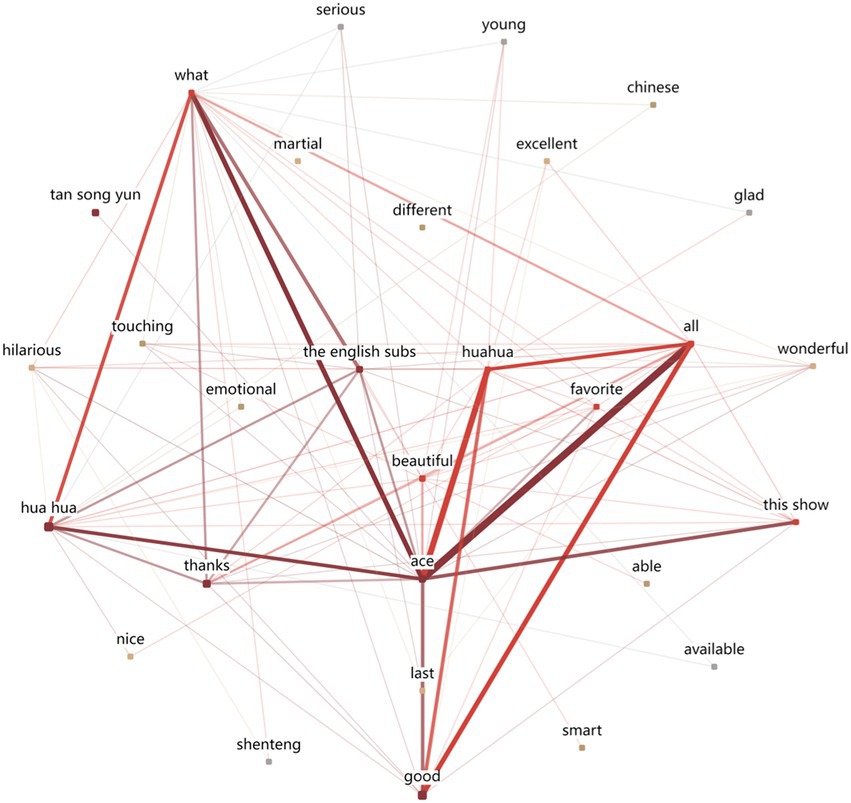
Figure 7. Ace Times S7 comment section keyword co-occurrence network relationship map – audience appreciates guest interactions and emotional appeal.
4.4.2.2 Youth Periplous S3
The analysis of Youth Periplous S3 reviews collected 644 valid comments, with a total vocabulary of 6,882 words, 1,275 valid words, and a word density of 18.53%. Sentiment analysis showed that 47.05% of the comments were positive, 48.45% were neutral, and 4.5% were negative (Grouped under “Games and competitions” in Table 3).
Emotional disposition analysis revealed generally positive feedback, with viewers praising the show’s entertainment, guest interactions, and relaxed atmosphere. The light-hearted travel theme and natural interactions among the stars were particularly appreciated. Neutral comments focused on program details and specific segments, while negative comments were related to misunderstandings of the program’s rules and values.
Co-occurrence network analysis highlighted frequent mentions of guest names like “Yang Yang” and “Guan Xiaotong,” reflecting viewers”attention to these stars. Terms like “hilarious,” “interesting,” and “entertaining” were common, underscoring the show’s entertainment value. The frequent reference to “English subtitles” indicated the program’s international reach and appreciation from overseas viewers (see Figure 8).
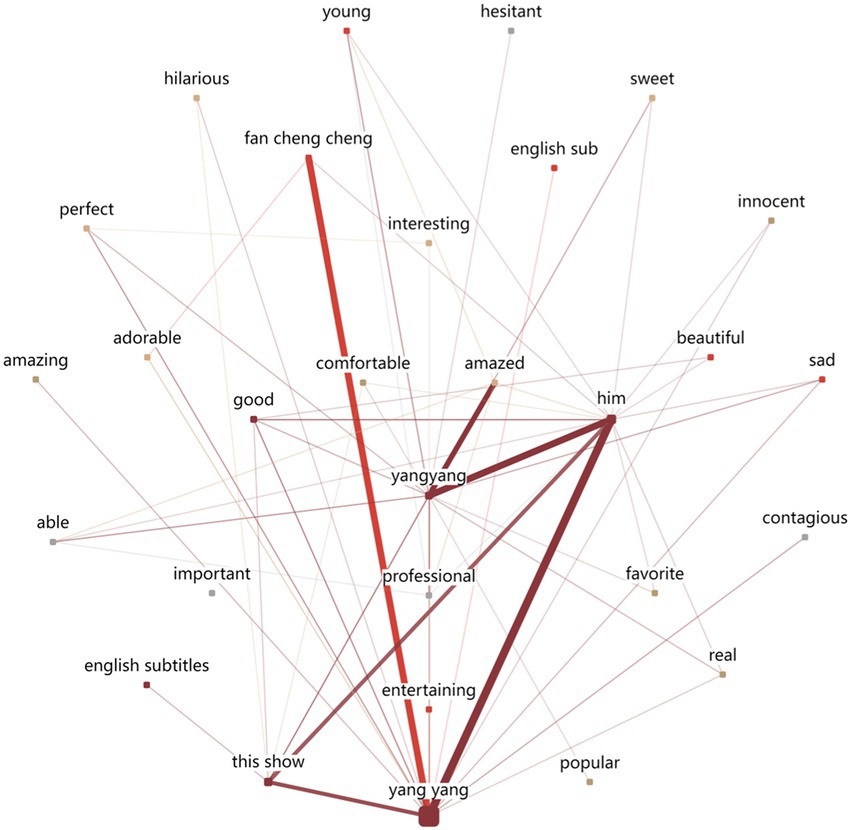
Figure 8. Youth Periplous S3 comment section keyword co-occurrence network relationship map – audience highlights entertainment value and guest interactions.
Overall, Youth Periplous S3 received positive reviews for its light-hearted format and guest interactions, though some viewers noted pacing issues and weaknesses in certain segments.
4.5 Outdoor living category
Outdoor lifestyle programs accounted for 20% of the ten programs screened for this work, with titles such as Back To Field S7 and Divas Hit The Road: Silk Road.
Back To Field S7 premiered on 28 April 2023. The main characters present viewers with an image of a laid-back rural idyll through their self-reliant and self-sufficient lifestyles. At the same time, the program reflects the desire of modern urbanites to get away from the hustle and bustle and return to nature.
Divas Hit The Road: Silk Road kicked off on 25 October 2023. In the first season, the program explores countries along the Belt and Road, showcasing the impact of Chinese companies and projects on the region. At the same time, the program reflects local customs and cross-cultural exchanges through interactions between the guests and the locals.
4.5.1 Text description
4.5.1.1 Back To Field S7
Table 2 shows that Back To Field S7 received 7,095 valid reviews, with 88.8% (6,298) in Chinese, 9.9% (702) in English, and 1.3% (95) in other languages.
As a slow-living outdoor reality show, the high percentage of Chinese reviews reflects its strong domestic appeal and alignment with the cultural and lifestyle preferences of Chinese viewers. The 9.9% of English comments indicates a certain level of international influence, with the program’s warm, natural atmosphere and celebrity guests attracting overseas viewers interested in Chinese culture and rural life.
The 1.3% of reviews in other languages, though small, shows interest from multilingual audiences. These viewers are likely drawn to the program’s “slow-paced” nature, resonating with China’s rural culture, natural landscapes, and idyllic countryside life.
4.5.1.2 Divas Hit The Road: Silk Road
As shown in Table 2, Divas Hit The Road: Silk Road received 8,255 valid reviews, with 64.8% (5,347) in Chinese, 31.3% (2,583) in English, and 3.9% (325) in other languages.
As a variety show combining travel and reality TV, exploring the history, culture, and natural scenery along the Silk Road, the program attracted a significant domestic and international audience, particularly those interested in travel history and culture. The large proportion of Chinese comments reflects the program’s strong appeal among Chinese-speaking viewers.
Nearly a third (31.3%) of the comments were in English, a relatively high percentage for this genre, indicating the show’s considerable international appeal. The Silk Road, as a historical and cultural link between East and West, resonates with English-speaking audiences, making the program’s global perspective a key factor in its popularity.
As an outdoor travel program, Divas Hit The Road: Silk Road presents content with considerable cultural depth, resulting in different core expectations among viewers from various cultural backgrounds. The analysis of the comment section reveals that foreign audiences primarily focus their discussions on the program’s exploration of cultural elements and introductions to countries along the Silk Road, frequently mentioning phrases such as “would love to see more cultural background information” and “this place is beautiful; I’d like to travel there,” reflecting their interest in authentic cultural experiences. In contrast, Chinese viewers’ comments often revolve around discussions about the guests, itinerary arrangements, and entertainment value of the show, with remarks like “this episode is entertaining” and “the interactions among guests are joyful.” This indicates that domestic viewers pay more attention to emotional resonance and entertainment rather than purely cultural content.
The 3.9% of comments in other languages suggests the program’s cultural richness and appeal to viewers from countries along the Silk Road, such as Turkey, Iran, and Kazakhstan.
4.5.2 Word frequency, sentiment and network co-occurrence analysis
4.5.2.1 Back To Field S7
Analyzing the Back To Field S7 reviews yielded 701 valid comments, with a total vocabulary of 8,823 words, 1,409 valid words, and a word density of 15.97%. Sentiment analysis showed that 43.37% of the comments were positive, 45.36% were neutral, and 11.27% were negative (Grouped under “Outdoor life” in Table 3).
Sentiment tendency analysis indicated that the program received largely positive feedback, with viewers appreciating its laid-back atmosphere and the relaxed interactions between guests. Positive comments focused on the portrayal of idyllic life and how the guests conveyed happiness through simplicity. Neutral comments mainly involved discussions of pacing and suggestions for improvement, while negative feedback, though less frequent, centered on dissatisfaction with certain program elements and perceived lack of innovation.
Co-occurrence network analysis, as shown in Figure 9, highlighted keywords like “Shen Yue,” “Henry,” and “idyllic life,” reflecting the focus on guest performances and the show’s theme. Words like “funny,” “cute,” and “excited” captured the audience’s positive view of the program’s charm. Additionally, “English subtitles” indicated international interest in the show.
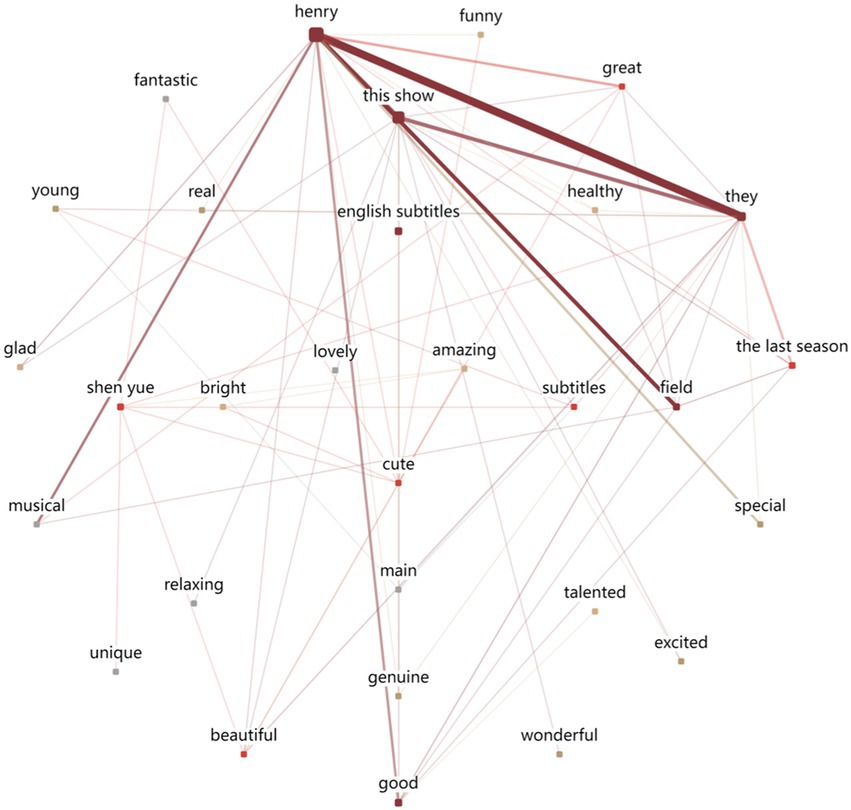
Figure 9. Back To Field S7 comment section keyword co-occurrence network relationship map – audience enjoys the idyllic atmosphere and relaxed guest interactions.
Overall, Back To Field S7 was well-received for its portrayal of simple living, though some viewers suggested the need for more innovation and content continuity.
4.5.2.2 Divas Hit The Road: Silk road
The analysis of Divas Hit The Road: Silk Road reviews yielded 2,582 valid comments, with a total vocabulary of 32,214 words, 4,399 valid words, and a word density of 13.66%. Sentiment analysis showed 46.4% positive comments, 48.14% neutral, and 5.46% negative (Grouped under “Outdoor life” in Table 3).
Viewers generally gave favorable feedback, with positive comments focusing on the guests’performances and the cultural exploration of the Silk Road. Many praised the combination of travel and cultural elements. Neutral comments were mainly suggestions on trip details and guest interactions, while negative feedback criticized certain segment designs and guest performances.
Co-occurrence network analysis revealed that keywords like “Reba” and “Wang Anyu” appeared frequently, showing high attention to guest performances, especially Diliheba’s. Words like “wonderful,” “interesting,” and “cultural” highlighted the audience’s appreciation of the program’s content and cultural elements (see Figure 10).
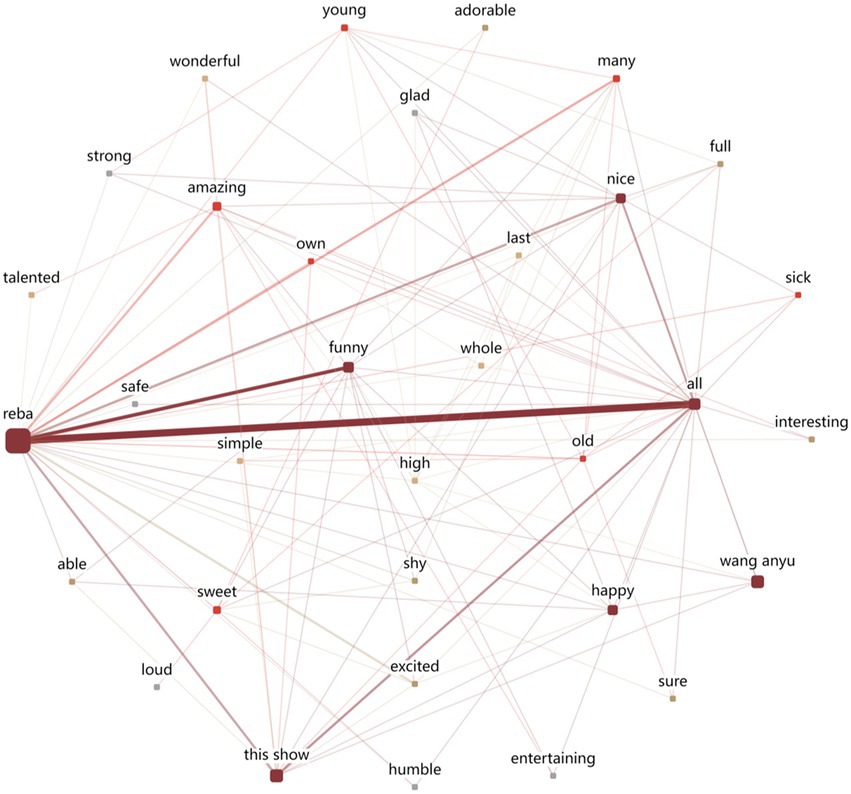
Figure 10. Divas Hit The Road: Silk Road comment section keyword co-occurrence network relationship map – audience values guest performances and cultural exploration.
Overall, Divas Hit The Road: Silk Road was well-received for its guest performances and cultural exploration, with suggestions for improving pacing and specific details.
5 Conclusion
Focusing on the cross-cultural communication effects of 10 Chinese variety shows, this work explored the performance of these shows on the YouTube platform through textual analysis, affective tendency analysis, and co-occurrence network analysis. We employed multi-dimensional quantitative and qualitative methods, such as word frequency analysis and sentiment classification to reveal various varieties’ communication characteristics in the context of cultural differences. Through the analysis of viewers’ comments, it was found that factors such as program genres, language adaptation (e.g., the presence or absence of English subtitles), the presentation of universal values, and the choice of guests significantly impact cross-cultural communication effects (see Figure 10).
Firstly, highly localized programs face significant cultural discount challenges in international markets. Due to the cultural differences between Chinese and foreign countries, overseas viewers have a significant comprehension bias towards the program’s cultural symbols and the historical context (Shi, 2024). Some scholars have pointed out that cultural discount can be attenuated by constructing multimodal cross-cultural symbols and unique narrative strategies (Lu and Qin, 2023). However, due to the high cultural dependency of such programs, mitigating this cultural discount remains challenging. In the future, Chinese variety shows can enhance international acceptance by providing richer subtitle content (such as adding cultural annotations and multilingual subtitles) and engaging in more cross-cultural collaborations (such as inviting international cultural scholars or foreign guests for interpretations), thus improving foreign audiences’ understanding of cultural content.
Secondly, subtitle quality is one of the critical factors contributing to the successful cross-cultural communication of Chinese variety shows. Some scholars have pointed out that subtitle translation is a language conversion and a cultural bridge that can greatly help viewers understand the cultural differences and background knowledge in programs (Hsiao, 2014). High-quality subtitle translation can effectively overcome cultural barriers and reduce the “cultural discount.” For shows involving historical and cultural themes, adding appropriate background annotations can help audiences better understand the core content. In music-related variety shows, lyric translations that consider rhyme and poetic imagery are more aligned with the linguistic preferences of the target audience. In the future, Chinese variety shows can strengthen subtitle production by learning from international platforms such as Netflix—providing multilingual subtitles and engaging subtitle groups to facilitate smoother transitions between languages and cultures. Additionally, utilizing open subtitle tools on international platforms like YouTube, allowing audiences to offer improvement suggestions or participate in translation, could further enhance subtitle accuracy and improve user experience.
Thirdly, the expression of universal values contributes significantly to enhancing the international influence of Chinese variety shows. Themes such as music, dance and other arts without borders, as well as the topic of independent women, are more readily accepted and understood by audiences through cross-cultural communication. Some scholars have emphasized that universal values are an essential part of cultural globalization and can play a vital role in the global spread of Chinese popular culture (Liu, 2024). Through the expression of music, dance and other art forms, viewers can cross the barriers of language and thus culture and deeply understand the emotions and ideas in the programs. In addition, the image of independent women has a universal appeal globally because it represents the awakening of their self-awareness and the right to make their own choices in modern society (McRobbie, 2009). Therefore, such themes are more likely to be successful in cross-cultural communication. In the future, program producers can proactively integrate content with greater international resonance, such as focusing on environmental protection, women’s empowerment, and multicultural exchange, thereby giving the programs a more global perspective. Additionally, strengthening interaction with international audiences through social media can further enhance acceptance in international markets.
Fourthly, the selection of celebrity guests significantly impacts the acceptance of variety shows in overseas markets. The core elements of reality TV shows are “people,” with the guests’ personality and characteristics directly impacting the development and quality of the discussed story. To attract viewers’ interest, guests need to show their unique personalities, fit the program’s theme and positioning, along with psychological solid qualities and high popularity. At the same time, the fitting of the guest with the program and its representativeness also directly affects the audience’s viewing experience (Fan, 2019). Additionally, collaboration with international streaming platforms (such as Netflix and Disney+) is an important pathway for enhancing the global influence of Chinese variety shows (Jin, 2023). Currently, the international dissemination of Chinese variety programs primarily relies on YouTube and Chinese platforms’ international editions. However, these platforms differ from traditional streaming services for content recommendation mechanisms and promotional strategies, leading to limitations in audience reach. In the future, cooperation between Chinese variety shows and global platforms like Netflix could leverage mature worldwide distribution channels to reach broader audiences. Moreover, utilizing the platforms’ localized translation teams and international promotional strategies could further improve the programs’ acceptance in diverse cultural markets.
Fifthly, the soft narrative perspective of outdoor life programs is often more transmittable in cross-cultural communication. Some scholars have pointed out that such “slow-paced” variety shows, which feature relaxed and natural outdoor life scenes and an atmosphere of cordial dialogue, present cultural content in a way that resonates with viewers. Most of the programs focus on the details of life and traditional culture, and instead of deliberately instilling them, they guide viewers to virtually experience the charm of foreign cultures through down-to-earth narratives (Wu, 2022). This narrative approach helps to reduce overseas viewers’ resistance to other cultures, improving the penetration and acceptance of the programs in cross-cultural communication. Chinese variety shows could incorporate richer cultural experience segments by inviting international guests, designing cross-cultural exchange tasks, or exploring globally popular travel destinations. These strategies would enhance overseas viewers’ sense of immersion, reduce cultural barriers, and increase program acceptance in international markets.
Finally, as a limitation of this work, it should be noted that the acceptance of overseas viewers is analyzed from cognitive and affective perspectives, whereas in the theoretical study of communication effects, audience behavior is also an essential dimension of analysis. Due to space constraints, only these two aspects were discussed. In the future, relevant research can also expand the sample size, introduce more variables, and further diversify research perspectives, to build a more comprehensive image of cross-cultural communication effects.
Data availability statement
The original contributions presented in the study are included in the article/supplementary material, further inquiries can be directed to the corresponding author.
Ethics statement
Ethical approval was not required for the study involving human data in accordance with the local legislation and institutional requirements. Written informed consent was not required, for either participation in the study or for the publication of potentially/indirectly identifying information, in accordance with the local legislation and institutional requirements. The social media data was accessed and analyzed in accordance with the platform's terms of use and all relevant institutional/national regulations.
Author contributions
YZ: Data curation, Investigation, Methodology, Software, Writing – original draft, Writing – review & editing.
Funding
The author(s) declare that no financial support was received for the research and/or publication of this article.
Acknowledgments
The author would like to thank Associate Professor Zhang Xin from the School of Journalism and Communication, Nanjing Normal University, for providing valuable feedback and suggestions on the manuscript.
Conflict of interest
The author declares that the research was conducted in the absence of any commercial or financial relationships that could be construed as a potential conflict of interest.
Generative AI statement
The authors declare that no Gen AI was used in the creation of this manuscript.
Publisher’s note
All claims expressed in this article are solely those of the authors and do not necessarily represent those of their affiliated organizations, or those of the publisher, the editors and the reviewers. Any product that may be evaluated in this article, or claim that may be made by its manufacturer, is not guaranteed or endorsed by the publisher.
References
Alvarado, O., Heuer, H., Abeele, V., Breiter, A., and Verbert, K. (2020). Middle-aged video Consumers' beliefs about algorithmic recommendations on YouTube. Proc. ACM Hum. Comput. Interact. 4, 1–24. doi: 10.1145/3415192
Andersen, M. M. T., Lüders, M., and Krogager, S. G. S. (2021). Streaming media production, interfaces, content and users. MedieKultur 37, 1–11. doi: 10.7146/mediekultur.v37i70.126152
Bai, R. Y. (2015) in Chinese television in the twenty-first century. ed. G. Song (New York: Routledge).
Burroughs, B. (2019). House of Netflix: streaming media and digital lore. Pop. Commun. 17, 1–17. doi: 10.1080/15405702.2017.1343948
Castells, M. (2006). The power of identity. 2nd Edn) (Cao Rongxiang, Trans.). Beijing, China: Social Sciences Academic Press.
Cho, J., Ahmed, S., Hilbert, M., Liu, B., and Luu, J. (2020). Do search algorithms endanger democracy? An experimental investigation of algorithm effects on political polarization. J. Broadcast. Electron. Media 64, 150–172. doi: 10.1080/08838151.2020.1757365
Croucher, S., and Condon, S. M. (2019). Hybridity and musical performance: the case of rap of China. J. Multicult. Discourses 14, 291–294. doi: 10.1080/17447143.2019.1640225
Dosekun, S. (2015). For western girls only? Post-feminism as transnational culture. Fem. Media Stud. 15, 960–975. doi: 10.1080/14680777.2015.1062991
Duan, P. (2021). Challenges, problems, and countermeasures in China's international communication. Modern commun. 8, 1–8 (in Chinese).
Fan, M. (2019). Analysis of the methods for selecting guests in domestic reality shows. Journal. Lover 9, 82–83 (in Chinese).
Gao, Y. (2024). Netflix overseas strategy: why is China the Most unnecessary market for Netflix? Commun. Soc. Media 7, 127–140.
Garrido, S., and Macritchie, J. (2018). Audience engagement with community music performances: emotional contagion in audiences of a ‘pro-am’ orchestra in suburban Sydney. Music. Sci. 24, 155–167. doi: 10.1177/1029864918783027
Guo, C. (2019). Chinese television and national identity construction: the cultural politics of music-entertainment programmes. Chin. J. Commun. 12, 224–226. doi: 10.1080/17544750.2019.1584470
Guo, L., and Vargo, C. J. (2020). Predictors of international news flow: exploring a networked global media system. J. Broadcast. Electron. Media 64, 418–437. doi: 10.1080/08838151.2020.1796391
Herbert, D., Lotz, A. D., and Marshall, L. (2019). Approaching media industries comparatively: a case study of streaming. Int. J. Cult. Stud. 22, 349–366. doi: 10.1177/1367877918813245
Hsiao, C. (2014). The cultural translation of U.S. television programs and movies: subtitle groups as cultural brokers in China (Doctoral dissertation). Los Angeles: University of California.
Hu, H. H. (2022). Optimised paths for TV variety shows in China according to paradigm shift of uses and gratifications approach in the era of new new media. Acad. J. Humanit. Soc. Sci. 5, 1–4. doi: 10.25236/AJHSS.2022.050401
Hu, Y. Z. (2023). Problems and countermeasures in the overseas practice of China's original variety show formats. Modern Audio Visual 3, 14–18 (in Chinese).
Hu, T. T., and Wang, M. Y. (2021). Paradoxical tomboyism: revived female masculinity in Chinese talent shows. Fem. Media Stud. 21, 499–503. doi: 10.1080/14680777.2021.1909093
Huntington, S. (2010). The clash of civilizations and the remaking of world order (Zhou Qi et al., Trans.). Beijing, China: Xinhua Publishing House.
Jakobsen, P. (2000). Focus on the CNN effect misses the point: the real media impact on conflict management is invisible and indirect. J. Peace Res. 33, 205–215. doi: 10.1177/0022343300037002001
Jiang, X. X. (2018). Parenting practices and gender roles in the modern Chinese family: Interculturalism in where are we going, dad? Telev. New Media 20, 460–475. doi: 10.1177/1527476418777729
Jin, D. (2023). Netflix’s effects on the Korean wave: power relations between local cultural industries and global OTT platforms. Asian J. Commun. 33, 452–469. doi: 10.1080/01292986.2023.2232368
Kaye, D., Chen, X., and Zeng, J. (2020). The co-evolution of two Chinese mobile short video apps: parallel platformization of Douyin and TikTok. Mobile Media Commun. 9, 229–253. doi: 10.1177/2050157920952120
Keane, M., and Zhang, J. D. (2017). Where are we going? Parent-child television reality programmes in China. Media Cult. Soc. 39, 630–643. doi: 10.1177/0163443716663641
Kotkin, J. (2010). Globalization: Race, religion, and cultural identity in the new global economy, (Wang Xu Trans.). Beijing, China: Social Sciences Academic Press, 8.
Kumar, A., and Semetko, H. A. (2018). Peace communication in cross-border media flows. J. Commun. 68, 612–635. doi: 10.1093/joc/jqy018
Li, T. (2020). Rhizome in the shadows: transplantation of Korean running man in the rise of screen-capitalism. Continuum 34, 73–87. doi: 10.1080/10304312.2019.1694139
Li, K. H. (2024). Research on TV programmes from the perspective of rhetoric: a case study of Chinese festival series programmes of Henan satellite TV. Acad. J. Humanit. Soc. Sci. 7, 186–190.
Liu, Y. (2012). A qualified person as the new target of compulsory education in China. Cross-Cultural Communication. 8, 78–84.
Liu, Z. (2024). The deterritorialisation of Chinese pop: a pilot study on the global presence of Chinese streaming services. Online Media Glob. Commun. 3, 181–212. doi: 10.1515/omgc-2023-0054
Lu, Y., and Qin, Z. (2023). Cross-cultural communication of Chinese food short videos under 'cultural discount' - a case analysis based on the 'Goldthread' video account. Southeast Commun. 11, 81–85 (in Chinese).
Lüders, M. (2020). Ubiquitous tunes, virtuous archiving and catering for algorithms: the tethered affairs of people and music streaming services. Inf. Commun. Soc. 24, 2342–2358. doi: 10.1080/1369118X.2020.1758742
Lüders, M., and Sundet, V. S. (2022). Conceptualizing the experiential affordances of watching online TV. Telev. New Media 23, 335–351. doi: 10.1177/15274764211010943
McRobbie, A. (2009). The aftermath of feminism: Gender, culture and social change. London, UK: Sage Publications.
Pang, B., and Lee, L. (2008). Opinion mining and sentiment analysis. Foundations and Trends in Information Retrieval. 2, 1–135.
Robertson, R. (1995). Glocalisation: time-space and homogeneity-Heterogeneity. Glob. Modern. 2, 25–44.
Said, E. W. (1999). Orientalism, (Wang Yugen Trans.). Beijing, China: SDX Joint Publishing Company, 260.
Shi, L. (2024). Research on the counter-cultural discount effect of cross-cultural variety shows. Sports Soc. Psychol. 4, 10–21. doi: 10.37420/j.ssp.2024.002
Song, L., Shi, Y., and Tso, G. (2021). Commercial audience retention of television programs: measurement and prediction. Int. J. Advert. 41, 435–461. doi: 10.1080/02650487.2021.1906541
Spilker, H. S., and Colbjørnsen, T. (2020). The dimensions of streaming: toward a typology of an evolving concept. Media Cult. Soc. 42, 1210–1225. doi: 10.1177/0163443720904587
Tana, J., Eirola, E., and Nylund, M. (2019). When is prime-time in streaming media platforms and video-on-demands services? New media consumption patterns and real-time economy. Eur. J. Commun. 35, 108–125. doi: 10.1177/0267323119894482
Theodorou, L., Healey, P., and Smeraldi, F. (2019). Engaging with contemporary dance: what can body movements tell us about audience responses? Front. Psychol. 10:71. doi: 10.3389/fpsyg.2019.00071
Tirasawasdichai, T., Obrenovic, B., and Alsharif, H. Z. H. (2022). The impact of TV series consumption on cultural knowledge: an empirical study based on gratification–cultivation theory. Front. Psychol. 13, 1–20. doi: 10.3389/fpsyg.2022.1061850
Wang, Z., and Lv, Y. (2023). Leveraging existing platforms for international reach of Chinese programs in the context of integrated media: a case study of Yawen Communication's operation on YouTube. Audio Visual World 1, 21–27 (in Chinese).
Wimmer, R. D., and Dominick, J. R. (2013). Mass media research: an introduction. Boston, MA, USA: Cengage Learning.
Wu, H. (2022). Analysis of narrative characteristics of slow variety show: take hello life as an example. Front. Art Res. 4, 84–88. doi: 10.25236/FAR.2022.041217
Keywords: Chinese variety shows, cross-cultural communication, YouTube, communication effect, cultural identity
Citation: Zhang Y (2025) The power of cross-cultural communication: reception and impact of Chinese variety shows on YouTube. Front. Commun. 10:1542139. doi: 10.3389/fcomm.2025.1542139
Edited by:
Anne Lucietto, Purdue University, United StatesReviewed by:
Rutthaphak Huttayavilaiphan, University of Phayao, ThailandTaejung Ma, Purdue University, United States
Copyright © 2025 Zhang. This is an open-access article distributed under the terms of the Creative Commons Attribution License (CC BY). The use, distribution or reproduction in other forums is permitted, provided the original author(s) and the copyright owner(s) are credited and that the original publication in this journal is cited, in accordance with accepted academic practice. No use, distribution or reproduction is permitted which does not comply with these terms.
*Correspondence: Yiyin Zhang, emhhbmd5aXlpbjk3QGZveG1haWwuY29t
 Yiyin Zhang
Yiyin Zhang